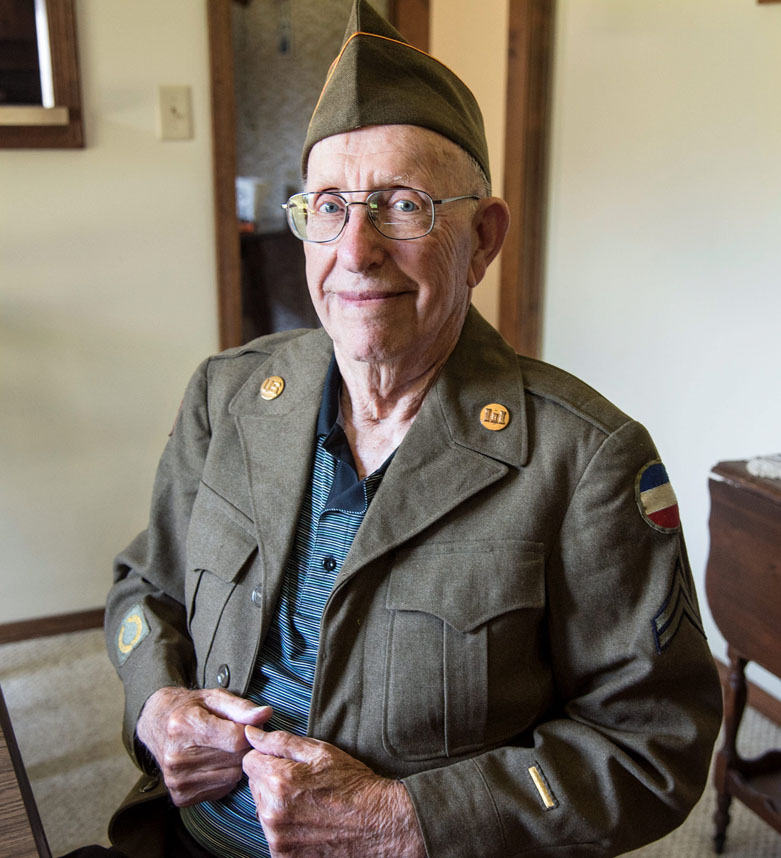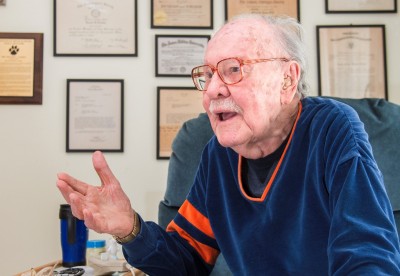Kenneth Roellig
By Paul Wood

Photo By Heather Coit/The News-Gazette
TOLONO — After zig-zagging on a ship through a U-Boat-infested Atlantic without escort, Sgt. Kenneth Roellig served in the infantry. He then became a combat engineer — and got on a ship prepared to invade Japan.
Roellig, 90, is well-known here after serving 31 years in the Unit 7 school district, including seven as superintendent.
He grew up in Windsor and was working for the railroad when he was drafted in 1944.
Along with 15,000 others on his troopship, he landed in Oran, Algeria, and from there went to sunny Naples, Italy.
Except Naples wasn’t so sunny.
“I didn’t realize it got that cold. I nearly froze to death in that tent,” he recalls.
Wiser soldiers knew to put their coats between the ground and themselves.
The Italians had already surrendered, and the Germans were on the run, he recalls. The most danger he faced in southern Italy came from his own troops.
“When they announced the Germans surrendered, we were on a hill. The troops in the valley started firing tracer rounds, and they came pretty close to hitting us,” he says.
Now the focus was on Japan.
He was transferred into the 643rd Engineer Combat Battalion, a battle-hardened unit that had already fought in North Africa and Italy.
They were to learn mine warfare, including how to deactivate Japanese mines.
In June, he was sent to school inside a white marble monument to Benito Mussolini, his planned centerpiece for the 1942 World’s Fair. The Esposizione Universale di Roma was to mark 20 years of fascism in Italy, as well as the Roman Empire.
Il Duce had even planned an arch to predate St. Louis’ Gateway Arch, only bigger.
“The school consisted of mine warfare and demolition for one week, and Bailey bridges for one week,” he recalls.
The Bailey bridge was a portable, pre-fabricated truss bridge made with invasions in mind.
The combat engineers were then sent to a staging area near Florence, made ready to take the next step, through the Panama Canal into the Pacific.
They were to leave Italy in early August, but the Mediterranean Sea was too rough for them to do so safely. And the harbor wasn’t deep enough, so when the soldiers did board, they had to go out to the ship, the David Shanks, in small boats.
“Shortly after passing through the Straits of Gibraltar, those who slept on deck noticed the stars were not where they were supposed to be,” Roellig remembers.
But it was announced there’d be no trip through the Panama Canal. The U.S. had dropped two atomic bombs, and Japan soon surrendered.
The David Shanks was heading home.
Roellig said he is grateful to President Harry Truman for making the decision to drop the bombs.
“Harry Truman is my best friend,” he says. “If not, the combat engineers would have been the first on the shores of Japan to clear the beaches.”
He was discharged July 24, 1946, at Fort Sheridan.
After getting his degree at the University of Illinois in teaching math, he had one teaching job before coming to Unit 7. Roellig has been retired since 1982.
He and his wife, Margaret, a retired librarian, have two children, four grandchildren and one great-grandchild.
Do you know a veteran who could share a story about military service? Contact staff writer Paul Wood at pwood@news-gazette.com.
Read more stories from local veterans:
 Frank Lesko
CHAMPAIGN — As an Army doctor, Frank Lesko climbed the tallest mountain in Japan and rescued an injured airman. On Aug. …
Frank Lesko
CHAMPAIGN — As an Army doctor, Frank Lesko climbed the tallest mountain in Japan and rescued an injured airman. On Aug. …
 Bon Bui
URBANA — Wounded six times in battle, Major Bon Bui spent 13 years starving in a prison and being “re-educated” in commu …
Bon Bui
URBANA — Wounded six times in battle, Major Bon Bui spent 13 years starving in a prison and being “re-educated” in commu …
 David Stangl
CHAMPAIGN — Whether it was protecting state-of-the-art weaponry or chasing after locals who’d broken through the perimet …
David Stangl
CHAMPAIGN — Whether it was protecting state-of-the-art weaponry or chasing after locals who’d broken through the perimet …